Types of Plagiarism and Definitions

Plagiarism is one of the most trending topics in the world right now. It used to be headaches of the teachers trying to police the assignments of their students but thanks to the internet, the availability of information and knowledge has become abundant and universal since plagiarism is needed to be discussed anywhere and everywhere writing is concerned.
Plagiarism Definitions:
By definition, when a writer or researcher poses as the creative intelligence behind the information or knowledge provided inside their writing although they are borrowed from a source that is rightly owned by someone else that would be called Plagiarism. Plagiarism is a punishable criminal offense under copyright law.
There are eight major types of plagiarism and it’s very important to be able to tell them apart. Let’s have a look at how they are different from one another –
- Complete Plagiarism
- Direct Plagiarism
- Source-based Plagiarism
- Paraphrasing Plagiarism
- Self Plagiarism
- Mosaic Plagiarism
- Misleading Attribution
- Accidental Plagiarism
Complete Plagiarism
Passing someone else’s work as your own is illegal and it is Complete Plagiarism by definition. Complete Plagiarism is also termed Global Plagiarism. Copying someone else’s writing and pasting it in your own would fall under this type of plagiarism. The crime of complete plagiarism is usually committed by someone who lacks the idea of how plagiarism works and the fact that readily available information and creativity of composition found on the internet are protected by copyright law.
Direct Plagiarism
Direct Plagiarism is a copy-pasted fraction of someone else’s write-up word-by-word without due credits given or permission taken. This type of plagiarism is also called Clone or Verbatim Plagiarism. Copying someone’s work like that is unethical and dishonest to start with. People often think they will get away with this kind of criminal offense but there are tools nowadays to detect this kind of plagiarism.
Source-based Plagiarism
Source-based plagiarism occurs when at least one of the many sources of the information is mistakenly or deliberately skipped. Since plagiarism is illegal, it doesn’t matter whether is it deliberate or not because it is considered intentional and the perpetrator is eligible for a fitting punishment. The opposite Source-Based Plagiarism occurs when authors are cited at the end of a written piece but their works have not actually contributed to the piece itself. Students often do it to fill up the citation section without going through the hassle of doing the actual research.
Paraphrasing Plagiarism
Even when you paraphrase something, you have to give credit to the author of the text you are paraphrasing from, or else, you will be guilty of Paraphrasing Plagiarism. A little bit of paraphrasing can take a piece away from Direct Plagiarism but paraphrasing does not give someone ownership of the information or composition of an authentic piece. Not that there has ever been much creativity involved in the act of paraphrasing but it’s even truer now since there are various paraphrasing tools and applications available on the internet.
Self Plagiarism
Self Plagiarism occurs when the author of a certain write-up republishes his/her work in entirety or in fragments under a different title which results in Self Plagiarism. It is also termed Auto Plagiarism or Duplication since they are responsible for pushing duplicate material to hit publication in repetition. People may take this kind of plagiarism lightly since stealing from yourself cannot practically be stealing in other cases but it is as harmful to the piece of writing in consideration as any other plagiarism.
Mosaic Plagiarism
When the author of any academic work steals or borrows portions of somebody else’s work without quotation marks or paraphrases the author’s sentences without adding any creativity or knowledge of his/her own, that is Mosaic Plagiarism or Patchwork Plagiarism. This kind of writing is usually termed “patchwriting” for there are patches of other people’s writing inside the author’s own. Not giving them the due credit makes it illegal which becomes an act of plagiarism.
Misleading Attribution
Misattribution or false attribution indicates that the quotations are misplaced accidentally or due to the lack of effort in conveying the credit to the real author. That is exactly what happens in the case of misleading attribution. It is also known as Inaccurate Authorship since the credit to the author is misplaced. In turn, there is an unfinished list of authors that had helped the manuscript to have come into being.
Accidental Plagiarism
Accidental Plagiarism is exactly what it sounds like - it is stealing someone else’s creative work without handing them the credit but accidentally. Looking out for this unintentional turn of events and learning how to cite the sources would be a great way to avoid such uncalled-for tragedies. A publishing author of any piece of writing should be responsible enough to care about where the information helping him/her is coming from and be grateful enough to extend the due courtesy of giving credit to the deserving party.

